2017 MERCEDES-BENZ S CLASS Front seats
[x] Cancel search: Front seatsPage 60 of 382

PRE-SAFE ®
takes the following measures
depending on the hazardous situation detected: R
the front seat belts are pre-tensioned. R
if the vehicle skids, the side windows and the
panorama roof with power tilt/sliding panel
are closed. R
the front-passenger seat is adjusted if it is in
an unfavorable position. R
for vehicles with electrically adjustable rear
seats: the outer rear seats are adjusted if they
are in an unfavorable position. R
vehicles with a multicontour seat: the air pres-
sure in the side bolsters of the seat backrest
is increased. R
vehicles with seat belt extenders: the seat
belts of the outer rear seats are pre-ten-
sioned.
If the hazardous situation passes without result-
ing in an accident, PRE-SAFE ®
slackens the belt
pre-tensioning. On vehicles with multicontour
seats, the air pressure in the side bolsters is
reduced again. All settings made by PRE-SAFE ®
can then be reversed.
If the seat belt pre-tensioning is not reduced: X
Move the seat backrest or seat back slightly
when the vehicle is stationary.
The seat belt pre-tensioning is reduced and
the locking mechanism is released.
The seat-belt adjustment is an integral part of
the PRE-SAFE ®
convenience function. Informa-
tion about the convenience function can be
found under "Belt adjustment" ( Y
page 47).
PRE-SAFE ®
PLUS (anticipatory occu-
pant protection system PLUS)
Introduction PRE-SAFE ®
PLUS is only available in vehicles
with the Driving Assistance package.
Using the radar sensor system, PRE-SAFE ®
PLUS is able to detect that a head-on or rear-end
collision is imminent. In certain hazardous sit-
uations, PRE-SAFE ®
PLUS takes pre-emptive
measures to protect the vehicle occupants. Important safety notes The intervention of PRE-SAFE ®
PLUS cannot
prevent an imminent collision.
The driver is not warned when PRE-SAFE ®
PLUS
intervenes.
PRE-SAFE ®
PLUS does not intervene if the vehi-
cle is backing up.
When driving, or when parking or exiting a park-
ing space with assistance from Active Parking
Assist, PRE-SAFE ®
PLUS will not apply the
brakes.
Function PRE-SAFE ®
PLUS intervenes in certain situa-
tions if the radar sensor system detects an
imminent head-on or rear-end collision.
PRE-SAFE ®
PLUS takes the following measures
depending on the hazardous situation detected: R
if the radar sensor system detects that a
head-on collision is imminent, the seat belts
are pre-tensioned. R
if the radar sensor system detects that a rear-
end collision is imminent: -
the brake pressure is increased if the driver
applies the brakes when the vehicle is sta-
tionary. -
the seat belts are pre-tensioned.
The PRE-SAFE ®
PLUS braking application is can-
celed: R
if the accelerator pedal is depressed when a
gear is engaged R
if the risk of a collision passes or is no longer
detected R
if DISTRONIC PLUS indicates an intention to
pull away
If the hazardous situation passes without result-
ing in an accident, the original settings are
restored.
Automatic measures after an acci-
dent
Immediately after an accident, the following
measures are implemented, depending on the
type and severity of the impact: R
the hazard warning lamps are activated R
the emergency lighting is activated R
the vehicle doors are unlocked58
Occupant safety
Safety
Page 61 of 382
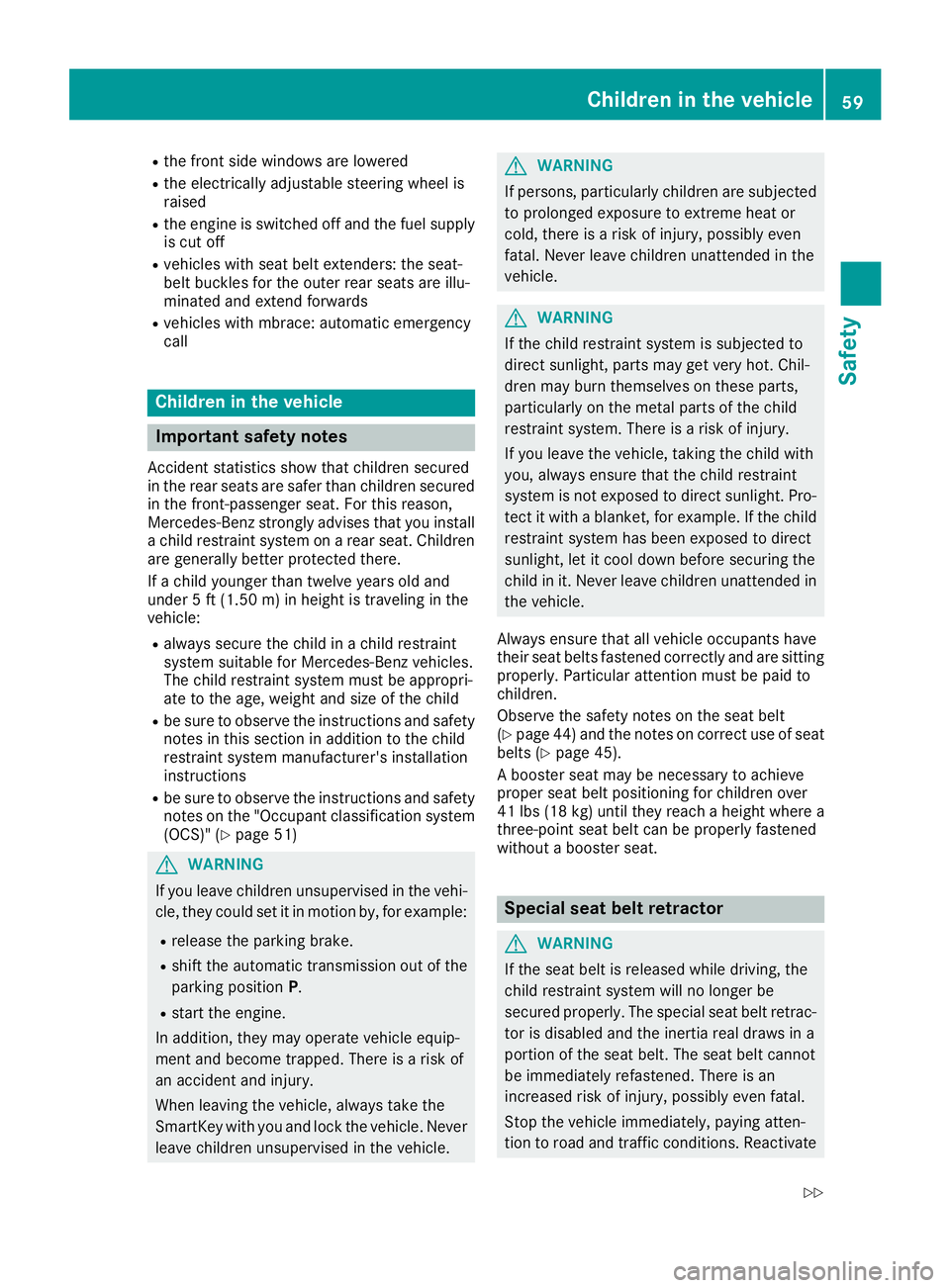
R
the front side windows are lowered R
the electrically adjustable steering wheel is
raised R
the engine is switched off and the fuel supply
is cut off R
vehicles with seat belt extenders: the seat-
belt buckles for the outer rear seats are illu-
minated and extend forwards R
vehicles with mbrace: automatic emergency
call
Children in the vehicle
Important safety notes Accident statistics show that children secured
in the rear seats are safer than children secured
in the front-passenger seat. For this reason,
Mercedes-Benz strongly advises that you install
a child restraint system on a rear seat. Children
are generally better protected there.
If a child younger than twelve years old and
under 5 ft (1.50 m) in height is traveling in the
vehicle: R
always secure the child in a child restraint
system suitable for Mercedes-Benz vehicles.
The child restraint system must be appropri-
ate to the age, weight and size of the child R
be sure to observe the instructions and safety
notes in this section in addition to the child
restraint system manufacturer's installation
instructions R
be sure to observe the instructions and safety
notes on the "Occupant classification system
(OCS)" ( Y
page 51)
G WARNING
If you leave children unsupervised in the vehi-
cle, they could set it in motion by, for example: R
release the parking brake. R
shift the automatic transmission out of the
parking position P .R
start the engine.
In addition, they may operate vehicle equip-
ment and become trapped. There is a risk of
an accident and injury.
When leaving the vehicle, always take the
SmartKey with you and lock the vehicle. Never
leave children unsupervised in the vehicle. G WARNING
If persons, particularly children are subjected
to prolonged exposure to extreme heat or
cold, there is a risk of injury, possibly even
fatal. Never leave children unattended in the
vehicle.
G WARNING
If the child restraint system is subjected to
direct sunlight, parts may get very hot. Chil-
dren may burn themselves on these parts,
particularly on the metal parts of the child
restraint system. There is a risk of injury.
If you leave the vehicle, taking the child with
you, always ensure that the child restraint
system is not exposed to direct sunlight. Pro-
tect it with a blanket, for example. If the child
restraint system has been exposed to direct
sunlight, let it cool down before securing the
child in it. Never leave children unattended in
the vehicle.
Always ensure that all vehicle occupants have
their seat belts fastened correctly and are sitting
properly. Particular attention must be paid to
children.
Observe the safety notes on the seat belt
( Y
page 44) and the notes on correct use of seat
belts ( Y
page 45).
A booster seat may be necessary to achieve
proper seat belt positioning for children over
41 lb s( 18 kg) until they reach a height where a
three-point seat belt can be properly fastened
without a booster seat.
Special seat belt retractor
G WARNING
If the seat belt is released while driving, the
child restraint system will no longer be
secured properly. The special seat belt retrac-
tor is disabled and the inertia real draws in a
portion of the seat belt. The seat belt cannot
be immediately refastened. There is an
increased risk of injury, possibly even fatal.
Stop the vehicle immediately, paying atten-
tion to road and traffic conditions. ReactivateChildren in the vehicle 59
Safety Z
Page 63 of 382
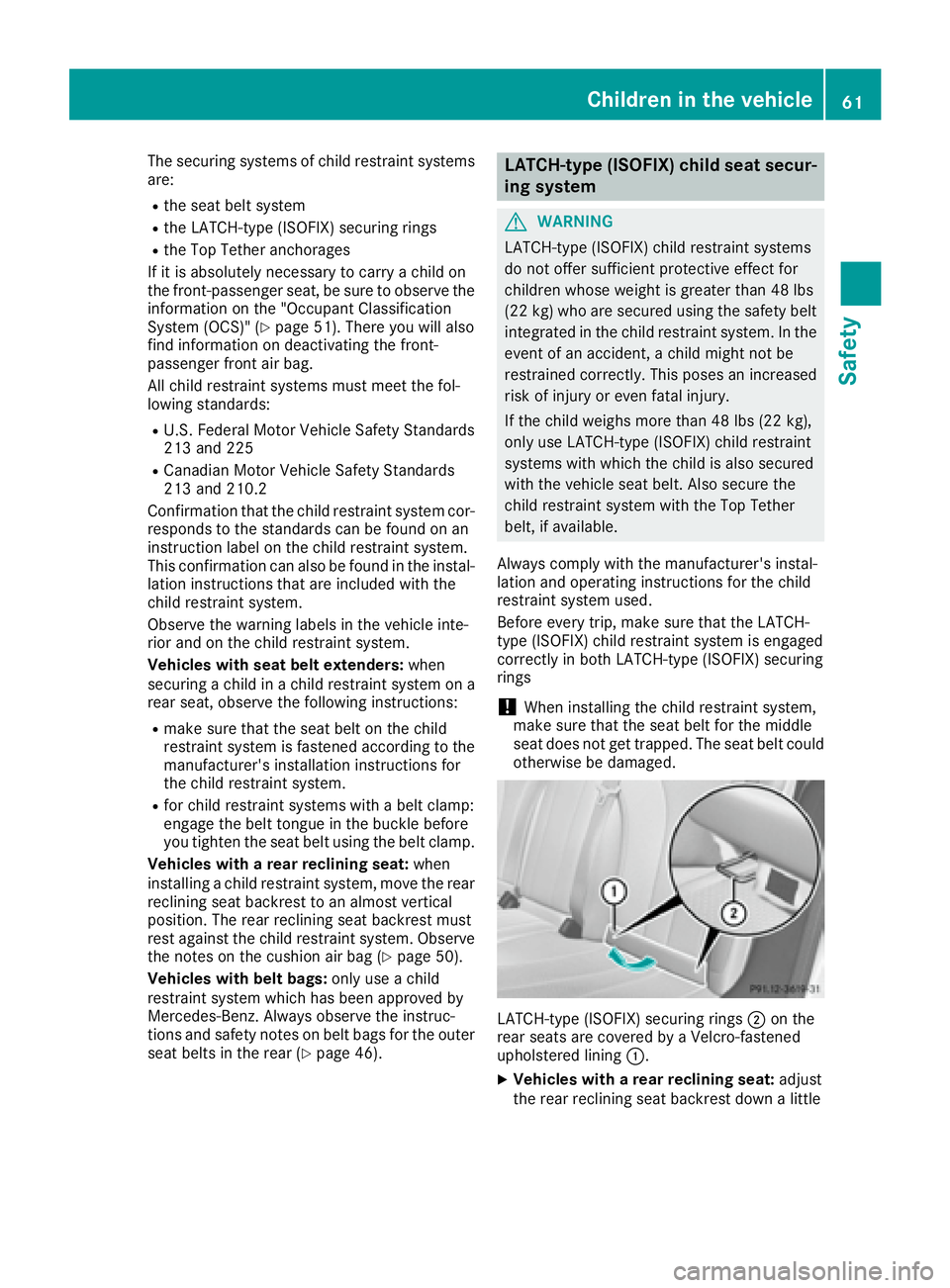
The securing systems of child restraint systems
are: R
the seat belt system R
the LATCH-type (ISOFIX) securing rings R
the Top Tether anchorages
If it is absolutely necessary to carry a child on
the front-passenger seat, be sure to observe the
information on the "Occupant Classification
System (OCS)" ( Y
page 51). There you will also
find information on deactivating the front-
passenger front air bag.
All child restraint systems must meet the fol-
lowing standards: R
U.S. Federal Motor Vehicle Safety Standards
213 and 225 R
Canadian Motor Vehicle Safety Standards
213 and 210.2
Confirmation that the child restraint system cor-
responds to the standards can be found on an
instruction label on the child restraint system.
This confirmation can also be found in the instal-
lation instructions that are included with the
child restraint system.
Observe the warning labels in the vehicle inte-
rior and on the child restraint system.
Vehicles with seat belt extenders: when
securing a child in a child restraint system on a
rear seat, observe the following instructions: R
make sure that the seat belt on the child
restraint system is fastened according to the
manufacturer's installation instructions for
the child restraint system. R
for child restraint systems with a belt clamp:
engage the belt tongue in the buckle before
you tighten the seat belt using the belt clamp.
Vehicles with a rear reclining seat: when
installing a child restraint system, move the rear
reclining seat backrest to an almost vertical
position. The rear reclining seat backrest must
rest against the child restraint system. Observe
the notes on the cushion air bag ( Y
page 50).
Vehicles with belt bags: only use a child
restraint system which has been approved by
Mercedes-Benz. Always observe the instruc-
tions and safety notes on belt bags for the outer
seat belts in the rear ( Y
page 46). LATCH-type (ISOFIX) child seat secur-
ing system
G WARNING
LATCH-type (ISOFIX) child restraint systems
do not offer sufficient protective effect for
children whose weight is greater than 48 lbs
(22 kg) who are secured using the safety belt
integrated in the child restraint system. In the
event of an accident, a child might not be
restrained correctly. This poses an increased
risk of injury or even fatal injury.
If the child weighs more than 48 lbs (22 kg),
only use LATCH-type (ISOFIX) child restraint
systems with which the child is also secured
with the vehicle seat belt. Also secure the
child restraint system with the Top Tether
belt, if available.
Always comply with the manufacturer's instal-
lation and operating instructions for the child
restraint system used.
Before every trip, make sure that the LATCH-
type (ISOFIX) child restraint system is engaged
correctly in both LATCH-type (ISOFIX) securing
rings
! When installing the child restraint system,
make sure that the seat belt for the middle
seat does not get trapped. The seat belt could
otherwise be damaged.
LATCH-type (ISOFIX) securing rings �D on the
rear seats are covered by a Velcro-fastened
upholstered lining �C .X
Vehicles with a rear reclining seat: adjust
the rear reclining seat backrest down a littleChildren in the vehicle 61
Safety Z
Page 103 of 382
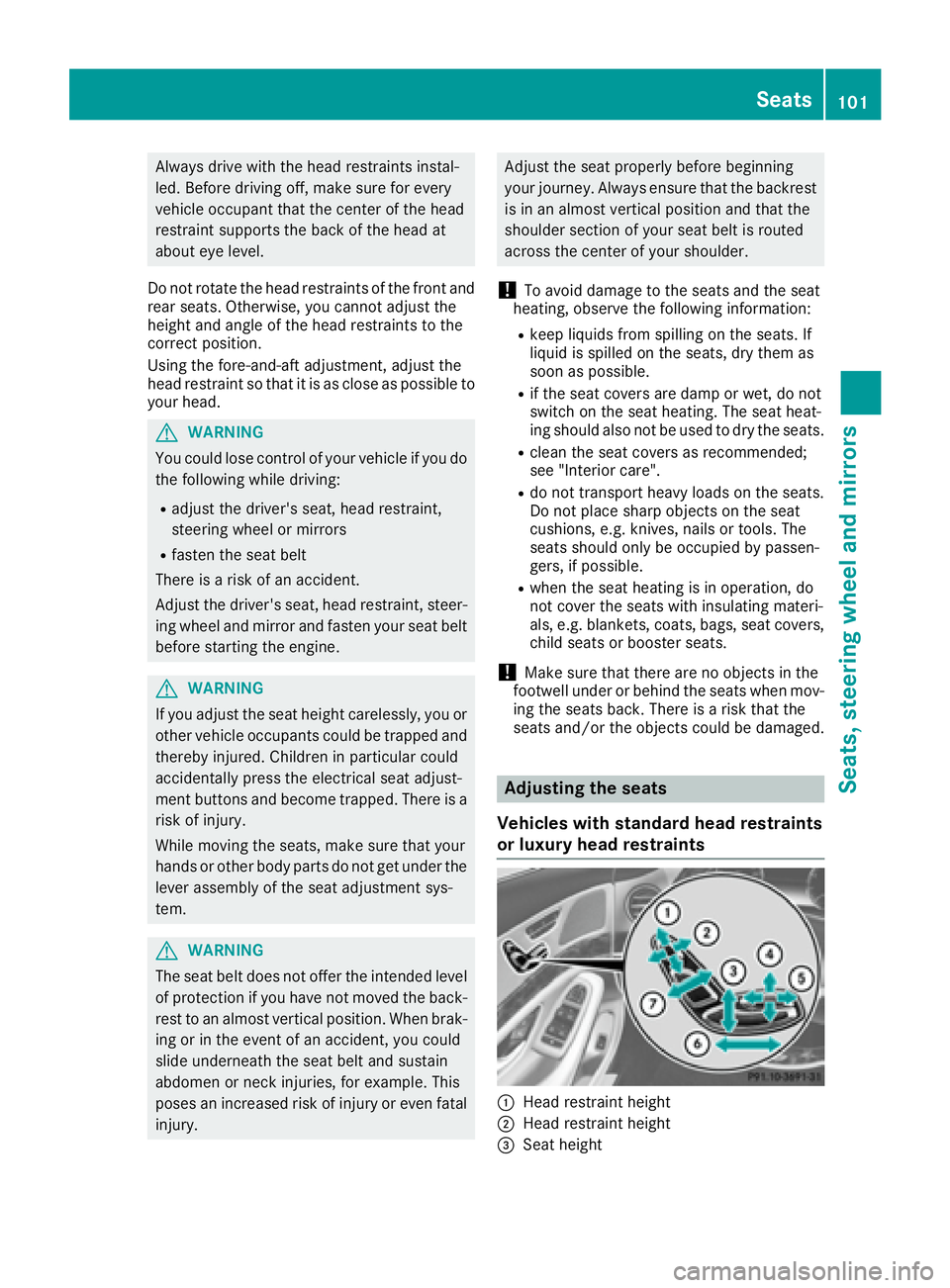
Always drive with the head restraints instal-
led. Before driving off, make sure for every
vehicle occupant that the center of the head
restraint supports the back of the head at
about eye level.
Do not rotate the head restraints of the front and
rear seats. Otherwise, you cannot adjust the
height and angle of the head restraints to the
correct position.
Using the fore-and-aft adjustment, adjust the
head restraint so that it is as close as possible to
your head.
G WARNING
You could lose control of your vehicle if you do
the following while driving: R
adjust the driver's seat, head restraint,
steering wheel or mirrors R
fasten the seat belt
There is a risk of an accident.
Adjust the driver's seat, head restraint, steer-
ing wheel and mirror and fasten your seat belt
before starting the engine.
G WARNING
If you adjust the seat height carelessly, you or
other vehicle occupants could be trapped and
thereby injured. Children in particular could
accidentally press the electrical seat adjust-
ment buttons and become trapped. There is a
risk of injury.
While moving the seats, make sure that your
hands or other body parts do not get under the
lever assembly of the seat adjustment sys-
tem.
G WARNING
The seat belt does not offer the intended level
of protection if you have not moved the back-
rest to an almost vertical position. When brak-
ing or in the event of an accident, you could
slide underneath the seat belt and sustain
abdomen or neck injuries, for example. This
poses an increased risk of injury or even fatal
injury. Adjust the seat properly before beginning
your journey. Always ensure that the backrest
is in an almost vertical position and that the
shoulder section of your seat belt is routed
across the center of your shoulder.
! To avoid damage to the seats and the seat
heating, observe the following information: R
keep liquids from spilling on the seats. If
liquid is spilled on the seats, dry them as
soon as possible. R
if the seat covers are damp or wet, do not
switch on the seat heating. The seat heat-
ing should also not be used to dry the seats. R
clean the seat covers as recommended;
see "Interior care". R
do not transport heavy loads on the seats.
Do not place sharp objects on the seat
cushions, e.g. knives, nails or tools. The
seats should only be occupied by passen-
gers, if possible. R
when the seat heating is in operation, do
not cover the seats with insulating materi-
als, e.g. blankets, coats, bags, seat covers,
child seats or booster seats.
! Make sure that there are no objects in the
footwell under or behind the seats when mov-
ing the seats back. There is a risk that the
seats and/or the objects could be damaged.
Adjusting the seats
Vehicles with standard head restraints
or luxury head restraints
�C
Head restraint height
�D
Head restraint height
�
Page 106 of 382

! Do not move the front-passenger seat fully
forwards if there are objects in the parcel net
in the front-passenger footwell. The objects
could otherwise be damaged.
Adjusting the front-passenger seat
The power supply or the ignition must be
switched on so that the front-passenger seat
can be selected ( Y
page 146).X
To select the front-passenger seat: press
button �C repeatedly until the indicator lamp
in the button lights up.
When the indicator lamp in button �C lights up,
for the front-passenger seat you can adjust: R
adjust the seat ( Y
page 101)R
seat heating ( Y
page 112)R
seat ventilation ( Y
page 113)R
the memory function to call up or save set-
tings ( Y
page 120).
Adjusting the front-passenger seat
from the rear
Important safety notes
G WARNING
Children could become trapped if they adjust
the seats, particularly when unattended.
There is a risk of injury.
When leaving the vehicle, always take the
SmartKey with you and lock the vehicle. Never
leave children unsupervised in the vehicle.
The seats can still be adjusted when the power
supply is switched off. G WARNING
When you adjust a seat, you or other vehicle
occupants could become trapped, e.g. on the
seat guide rail. There is a risk of injury.
Make sure when adjusting a seat that no one
has any body parts in the sweep of the seat.
Observe the safety notes on "Air bags"
( Y
page 48) and "Children in the vehicle"
( Y
page 59).
G WARNING
The front-air bags for could also injure the
vehicle occupants in the front If the front
seats are positioned too close to the dash-
board or steering wheel. This poses an
increased risk of injury or even fatal injury.
Always adjust the front seats so that they are
as far from the front air bags as possible. Also
observe the notes on the correct adjustment
of the seats.
! Do not move the front-passenger seat fully
forwards if there are objects in the parcel net
in the front-passenger footwell. The objects
could otherwise be damaged.
i You can use the rear-compartment override
button to disable the setting of the front-
passenger seat from the rear ( Y
page 65).
Adjusting the rear seat
�C
Selects rear-compartment seat
�D
Head restraint height
�
Page 109 of 382

Adjusting fr om th e rear compar tm ent
You can use th e override butto n to disable this
function ( Y
page 65).
In order for th e front-passenger seat to be posi -
tione d in chauffeur mode:R
th e power suppl y or th e ignition must be
switched on ( Y
page 146)R
th e front-passenger seat may no t be occupiedR
th e front-passenger seat belt must no t be
inserted int o th e buckleX
To select th e fr ont-passenger seat : press
butto n �C repeatedly until th e indicator lamp
in th e butto n lights up.
The front-passenger seat is selected if th e
indicator lamp in th e butto n lights up.X
Press butto n �D forwards and hold it in this
position.
The seat moves forward.
The seat stops at th e threshold of th e area for
chauffeur mode. X
Releas e butto n �D .X
Press and hold butto n �D again until th e front-
passenger seat is in positio n for chauffeur
mode.
The head restraint on th e front-passenger
seat folds forward. The seat moves forward.
The To vie w the ext . mirror , adjust
front-passenger sea t or remove the
hea d restraint . message appear s in th e
multifunction display ( Y
page 256).
i If th e front-passenger seat is already at th e
threshold to th e area for th e chauffeur mode,
th e positio n for th e chauffeur mod e is set
immediately.
i The positio n for chauffeur mod e can be
saved or set usin g th e memory function of th e
rear seat ( Y
page 121). Fo r this th e indicator
lamp on butto n �C must be lit . Adjusting fr om th e driver's seat
In order for th e front-passenger seat to be posi -
tione d in chauffeur mode: R
th e power suppl y or th e ignition must be
switched on ( Y
page 146) R
th e front-passenger seat may no t be occupiedR
th e front-passenger seat belt must no t be
inserted int o th e buckle X
To select th e fr ont-passenger seat : press
butto n �C repeatedly until th e indicator lamp
in th e butto n lights up.
The front-passenger seat is selected if th e
indicator lamp in th e butto n lights up.X
Press butto n �D forwards and hold it in this
position.
The seat moves forward.
The seat stops at th e threshold of th e area for
chauffeur mode. X
Releas e butto n �D .X
Press and hold butto n �D again until th e front-
passenger seat is in positio n for chauffeur
mode.
The head restraint on th e front-passenger
seat folds forward. The seat moves forward.
The To vie w the ext . mirror , adjust
front-passenger sea t or remove the
hea d restraint . message appear s in th e
multifunction display ( Y
page 256).
i If th e front-passenger seat is already at th e
threshold to th e area for th e chauffeur mode,
th e positio n for th e chauffeur mod e is set
immediately.
i The positio n for chauffeur mod e canno t be
store d or set wit h th e driver' s seat memory
function .Seats 107
Seats, steering wheel and mirrors Z
Page 112 of 382
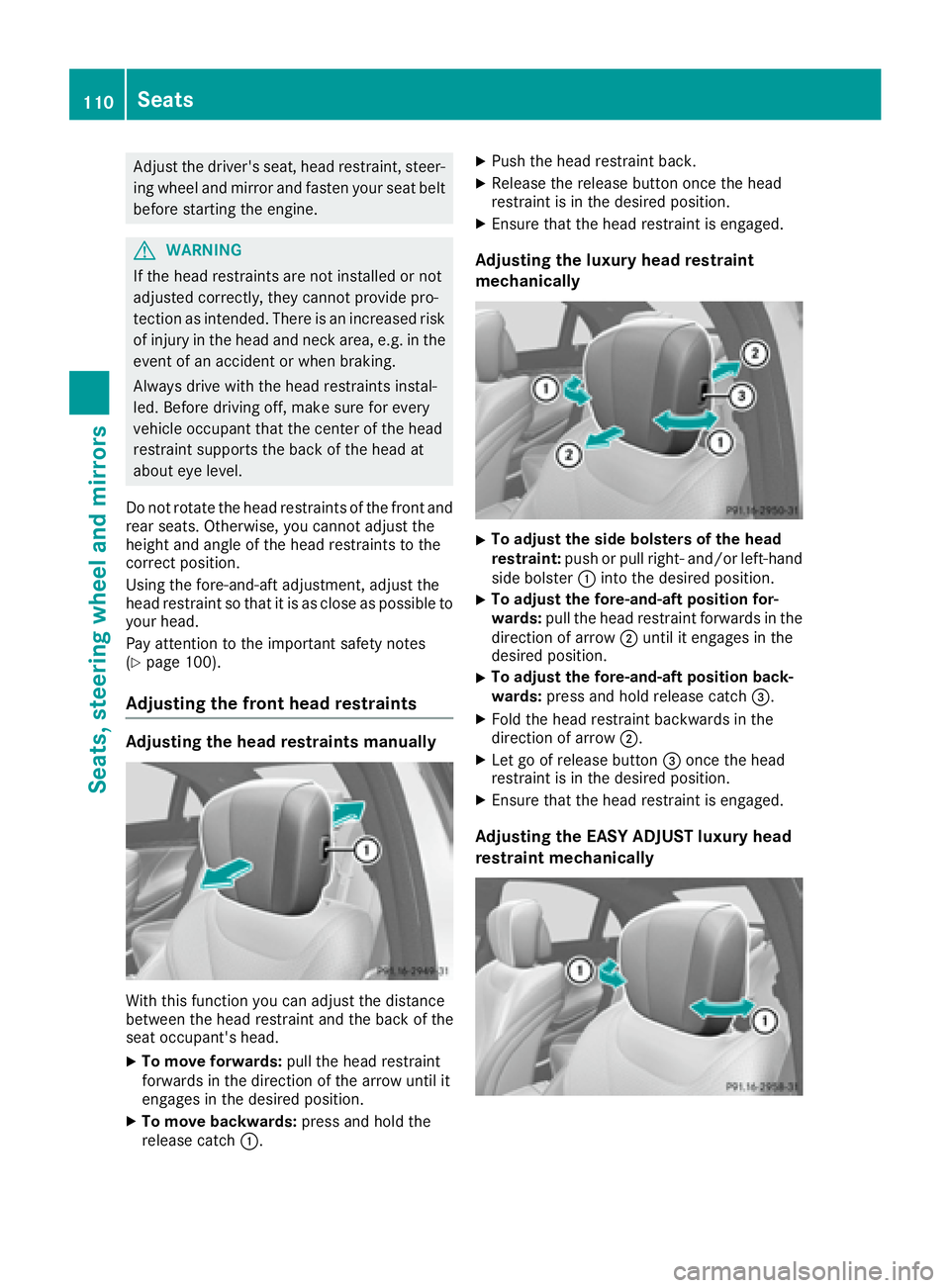
Adjust the driver's seat, head restraint, steer-
ing wheel and mirror and fasten your seat belt
before starting the engine.
G WARNING
If the head restraints are not installed or not
adjusted correctly, they cannot provide pro-
tection as intended. There is an increased risk
of injury in the head and neck area, e.g. in the
event of an accident or when braking.
Always drive with the head restraints instal-
led. Before driving off, make sure for every
vehicle occupant that the center of the head
restraint supports the back of the head at
about eye level.
Do not rotate the head restraints of the front and
rear seats. Otherwise, you cannot adjust the
height and angle of the head restraints to the
correct position.
Using the fore-and-aft adjustment, adjust the
head restraint so that it is as close as possible to
your head.
Pay attention to the important safety notes
( Y
page 100).
Adjusting the front head restraints
Adjusting the head restraints manually
With this function you can adjust the distance
between the head restraint and the back of the
seat occupant's head. X
To move forwards: pull the head restraint
forwards in the direction of the arrow until it
engages in the desired position. X
To move backwards: press and hold the
release catch �C . X
Push the head restraint back. X
Release the release button once the head
restraint is in the desired position. X
Ensure that the head restraint is engaged.
Adjusting the luxury head restraint
mechanically X
To adjust the side bolsters of the head
restraint: push or pull right- and/or left-hand
side bolster �C into the desired position. X
To adjust the fore-and-aft position for-
wards: pull the head restraint forwards in the
direction of arrow �D until it engages in the
desired position. X
To adjust the fore-and-aft position back-
wards: press and hold release catch �
Page 113 of 382
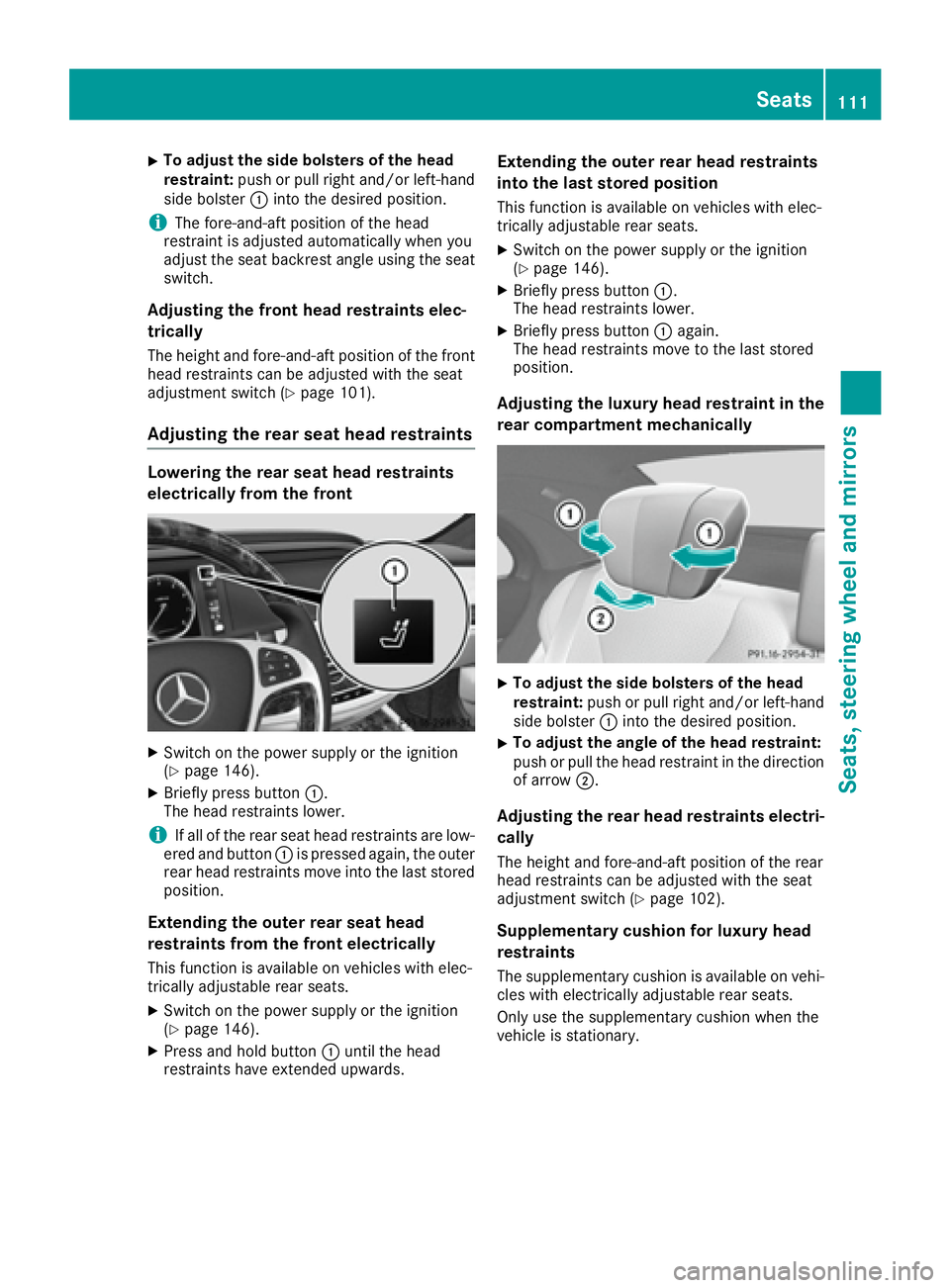
X
To adjust the side bolsters of the head
restraint: push or pull right and/or left-hand
side bolster �C into the desired position.
i The fore-and-aft position of the head
restraint is adjusted automatically when you
adjust the seat backrest angle using the seat
switch.
Adjusting the front head restraints elec-
trically The height and fore-and-aft position of the front
head restraints can be adjusted with the seat
adjustment switch ( Y
page 101).
Adjusting the rear seat head restraints Lowering the rear seat head restraints
electrically from the front
X
Switch on the power supply or the ignition
( Y
page 146). X
Briefly press button �C .
The head restraints lower.
i If all of the rear seat head restraints are low-
ered and button �C is pressed again, the outer
rear head restraints move into the last stored
position.
Extending the outer rear seat head
restraints from the front electrically
This function is available on vehicles with elec-
trically adjustable rear seats. X
Switch on the power supply or the ignition
( Y
page 146). X
Press and hold button �C until the head
restraints have extended upwards. Extending the outer rear head restraints
into the last stored position This function is available on vehicles with elec-
trically adjustable rear seats. X
Switch on the power supply or the ignition
( Y
page 146). X
Briefly press button �C .
The head restraints lower. X
Briefly press button �C again.
The head restraints move to the last stored
position.
Adjusting the luxury head restraint in the
rear compartment mechanically
X
To adjust the side bolsters of the head
restraint: push or pull right and/or left-hand
side bolster �C into the desired position. X
To adjust the angle of the head restraint:
push or pull the head restraint in the direction
of arrow �D .
Adjusting the rear head restraints electri-
cally
The height and fore-and-aft position of the rear
head restraints can be adjusted with the seat
adjustment switch ( Y
page 102).
Supplementary cushion for luxury head
restraints
The supplementary cushion is available on vehi-
cles with electrically adjustable rear seats.
Only use the supplementary cushion when the
vehicle is stationary. Seats 111
Seats, steering wheel an d mirrors Z